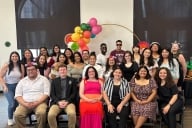You have /5 articles left.
Sign up for a free account or log in.
One might hope that the economic recession, which formally ended in 2009, is no longer inhibiting students’ educational pursuits -- or, perhaps more realistically, not as much.
But an annual survey of freshmen suggests precisely the opposite: more students than ever (66.6 percent) say America’s economic condition significantly affected their choice of college -- so the recession’s residual effects, at least, linger on.
And financial considerations are affecting students in more ways than just where they enroll. The survey also found all-time highs in the number of students who said that “to be able to get a better job” (87.9 percent) and “to be able to make more money” (74.6 percent) were “very important” reasons to go to college; that “being very well-off financially” is a personal goal (81 percent); and that “the cost of attending this college” (43.3 percent) and “not offered aid by first choice” (9.5 percent) were important reasons for choosing the college they are attending.
“When we start to see all those items stack up, that stands out to us,” said Laura Palucki Blake, co-author of this year’s “The American Freshman: National Norms,” an annual survey and report published by UCLA’s Cooperative Institutional Research Program. “That says to us, there’s a need for universities to talk about this and to say, ‘Here is the lay of the land with incoming first-years, and this is really an issue for them.’ ”
CIRP surveyed 192,912 first-time, full-time students entering 283 institutions of varying type and selectivity in fall 2012. (This year's National Survey on Student Engagement, which includes students of all grade levels, also found a strong connection between financial worries and academic activity.)
Despite the considerably grim outlook this year’s freshmen have on money, Palucki Blake said there’s reason to think positively about it.
“I don’t necessarily see it as a negative. I see it as a reality, and I see it as an opportunity for colleges and universities to get out there and to say, ‘This may be why you’re coming to college…. but don’t let that limit you,' ” she said. “The idea is to help students navigate these four years, and let them see their potential for long-term success.”
Only, judging by another finding of this year’s survey, freshmen might be navigating for longer than they think. Although the vast majority of freshmen (84.3 percent) believe they will graduate in four years, the report notes, federal IPEDS data from the respondents’ institutions suggest that only 40.6 percent will do so. Therein lies an important lesson for students and the colleges that enroll them, Palucki Blake said.
“They may be making their choices based on cost, but not realizing actually in the long term it’s going to cost them more because they’re going to be there an extra year,” she said.
Students should know institutions’ graduation rates before enrolling, Palucki Blake said, which means colleges need to share that information and have counselors open to honest discussions.
Although 76.7 percent of students report being accepted at their first-choice institution, only 59.3 percent enrolled there. As the report notes, that figure is significantly lower than it was three and four decades ago, when 75 percent of students went with their first pick.
Finances might also have something to do with the fact that fewer students live in residence halls this year (76.1 percent in 2012, down from 79.3 percent in 2011), and more live at home (17.2 percent this year and 15 percent in 2011). More than half of these students (57.3 percent) said the cost of their college was a “very important” reason to go there. They are also more likely to plan on working to help pay for college (55.6 percent, compared to 47.8 percent of students living in dorms).
That coupling suggests colleges should consider the availability of services for students who are living at home and working full time, Palucki Blake said, because they’re likely to be on campus far less than their peers.
Last year, the report noted that while students were more likely than the year prior to identify as “middle-of-the-road” politically (and thus less likely to call themselves “liberal” or “conservative”), their collective outlook on social issues leaned to the left. That held mostly true over the course of two presidential elections.
In 2008, 44.2 percent of men and 42.5 percent of women identified as middle-of-the-road. By 2012, those figures had risen slightly to 48 and 47 percent, respectively. Men identifying as liberal or far-left dropped from 30.3 to 26.4 percent; for women that number dropped from 37.4 to 32.3 percent. And for those identifying as conservative or far-right, the percentages actually rose very slightly, 0.1 percentage point for men, to 25.6 percent, and 0.7 percentage points for women, to 20.7 percent.
Students’ positions on hot-button social issues varied. While the number of those who agreed “strongly” or “somewhat” that abortion should be legal rose from 58.2 percent in 2008 to 61.1 percent in 2012, those who said “a national health care plan is needed to cover everybody’s medical costs” dropped from 70.3 to 62.7 percent. Although the number of students saying racial discrimination is “no longer a major problem in America” rose from 20.1 to 23 percent, more of them also agree that “students from disadvantaged social backgrounds should be given preferential treatment in college admissions": 41.9 percent this fall, compared to 39.5 percent four years ago. Finally, more students say the wealthy should pay more taxes (64.6 percent in 2012, 60.4 percent in 2008).
Perhaps in a note to the former presidential candidate Rick Santorum and his ilk, the report makes an additional observation.
“A number of studies using CIRP data have pointed out that some students become more liberal in their political orientation during college,” it says. “Study after study concludes that any change in the political orientation that occurs among students during college is predominantly influenced by the political orientation of their fellow students, and the overall campus climate perpetuated by their peers, not by the political orientation of the faculty.”
Major Majors
The survey also inquired about students’ majors. Business was again the most popular, with 14.4 percent of students planning to study it. The next-most popular majors were the health professions (14.1 percent), biological sciences (12.6 percent), and engineering (10.4 percent).
Regardless of major, students this year continued an upward trend in academic “habits of mind.” Just over 57 percent ask questions in class, 50.5 percent revise their papers to improve their writing, and 41.8 percent report “frequently evaluating the quality or reliability of information.” The largest increase in the five years since CIRP began using this set of questions was found in the proportion of students looking up scientific research articles and resources – that’s up to 27.4 percent, compared to 22.1 percent in 2008.
And consistent with past years, more students say they were frequently “overwhelmed” by all they had to do their last year in high school; 30.4 percent of freshmen agreed with that statement this year, up from 28.5 percent last year. Women are more than twice as likely than men to agree (40.5 percent – the highest that figure’s been since the question was first asked in 1985 -- compared to 18.3 percent).
The students who said they felt overwhelmed were also less likely to report high emotional health (40.2 percent vs. 67.4 percent for the non-overwhelmed).
“The obvious concern is that students who report feeling overwhelmed in high school might continue feeling overwhelmed in college,” Palucki Blake said, adding that the finding speaks to the need for colleges to provide good mental health services and student activities to reduce stress.
In a section on math preparation, the report notes a stark difference between students attending historically black colleges and universities and those at other colleges. A total of 12.6 percent of students at HBCUs completed calculus in high school, lower than the rates of students at private universities (47.3 percent), public four-year colleges (20 percent), public universities (33.8 percent), and private four-year colleges (28.1 percent).
While even more students at private universities came in having completed Advanced Placement courses in probability and statistics and AP calculus (48.9 percent), only 8.6 percent of students at HBCUs did. The group with the next-lowest rates in that category was students at public four-year colleges, 18.7 percent of whom completed the classes.
More HBCU students completed pre-calculus or trigonometry, but still at lower rates than others: 63.5 percent of students at HBCUs did so, compared to 85 percent of public university students and 91.2 percent of private university students.
But the report adds this note: while students at HBCUs are less prepared mathematically, other UCLA research has shown those institutions’ “effectiveness” in graduating students in science, technology, engineering and mathematics.









